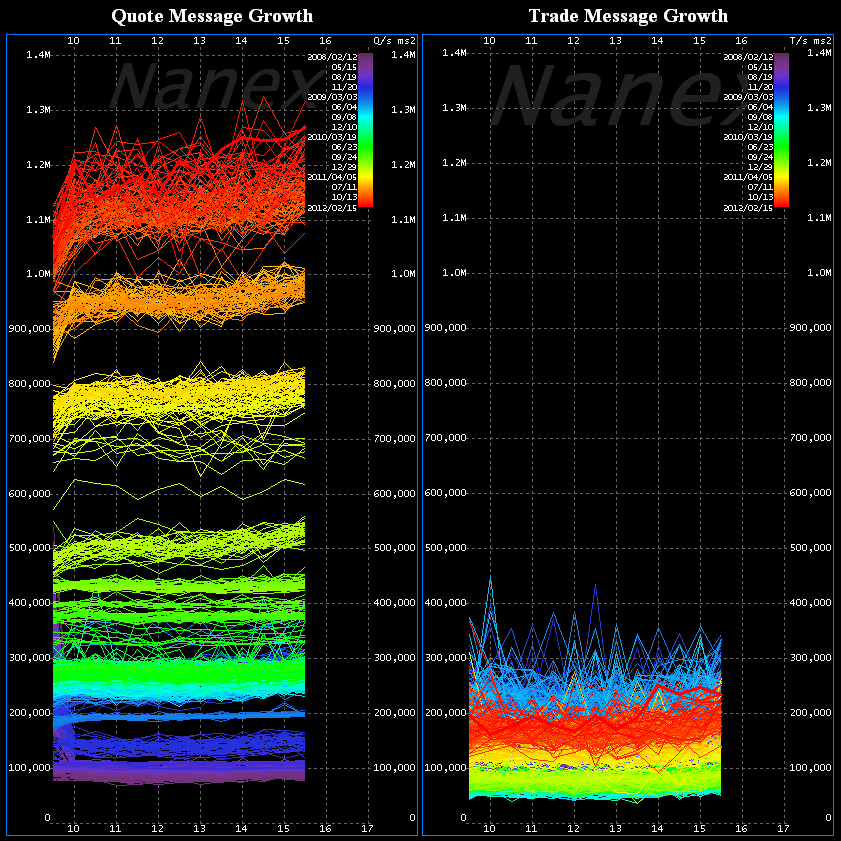Mysterious Algorithm Was 4% of Trading Activity Last Week
Post on: 11 Июнь, 2015 No Comment

A single mysterious computer program that placed orders — and then subsequently canceled them — made up 4 percent of all quote traffic in the U.S. stock market last week, according to the top tracker of high-frequency trading activity. The motive of the algorithm is still unclear.
The program placed orders in 25-millisecond bursts involving about 500 stocks, according to Nanex, a market data firm. The algorithm never executed a single trade, and it abruptly ended at about 10:30 a.m. ET Friday.
“Just goes to show you how just one person can have such an outsized impact on the market,” said Eric Hunsader. head of Nanex and the No. 1 detector of trading anomalies watching Wall Street today. “Exchanges are just not monitoring it.”
Hunsader’s sonar picked up that this was a single high-frequency trader after seeing the program’s pattern (200 fake quotes, then 400, then 1,000) repeated over and over. Also, it was being routed from the same place, the Nasdaq.
“My guess is that the algo was testing the market, as high-frequency frequently does,” says Jon Najarian, co-founder of TradeMonster.com. “As soon as they add bandwidth, the HFT crowd sees how quickly they can top out to create latency.” (Read More. Unclear What Caused Kraft Spike: Nanex Founder .)
Translation: The ultimate goal of many of these programs is to gum up the system so it slows down the quote feed to others and allows the computer traders (with their co-located servers at the exchanges) to gain a money-making arbitrage opportunity.
The scariest part of this single program was that its millions of quotes accounted for 10 percent of the bandwidth that is allowed for trading on any given day, according to Nanex. (The size of the bandwidth pipe is determined by a group made up of the exchanges called the Consolidated Quote System.) (Read More. Cuban, Cooperman: Curb High-Frequency Trading .)
“This is pretty out there to see this affect this many stocks at the same time,” said Hunsader, adding that high-frequency traders are doing anything to “tip the odds in their favor.”
A Senate panel at the end of September sought answers on high-frequency trading, as investigators look into the best way to stop wealth-destroying events such as the Knight Capital Group computer glitch in August and the market “flash crash” two years ago. (Read More. Ex-Insider Calls High-Frequency Trading ‘Cheating’ .)

Regulators are trying to see how they can rein in the practice, which accounts for 70 percent of trading each day, without slowing down progress and profits for Wall Street and the U.S. exchanges.
“I feel a tax on order-stuffing is what the markets need at this point,” said David Greenberg of Greenberg Capital. “This will cut down on the number of erroneous bids and offers placed into the market at any given time and should help stabilize the trading environment.”
Hunsader warned that regulators better do something fast, speculating that this single program could have led to something very bad if big news broke, or if a sell-off occurred and one entity was hogging this much of the system.
For the best market insight, catch “Fast Money” each night at 5 p.m. ET, and the “Halftime Report” each afternoon at 12:00 ET on CNBC. Follow @CNBCMelloy on Twitter.
______________________________________________________
Got something to say? Send us an e-mail at fastmoney-web@cnbc.com and your comment might be posted on the Rapid Recap. If you’d prefer to make a comment, but not have it published on our Web site, send your message to fastmoney@cnbc.com .














